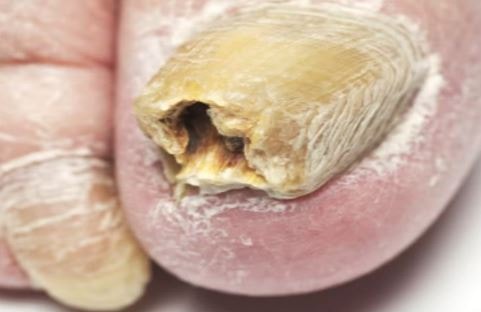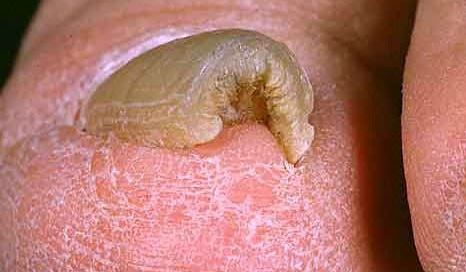Thick Toenails
What are Thick Toenails?
Thickening of the toenails may occur to the older population as part of the normal physiologic process, but if this happened to a younger individual, it may be caused by several factors such as trauma or nail pathology [1, 2].

Figure 1 shows an example of a thickened toenail.
Anatomy and Pathophysiology of Toenails
The toenails are composed of hard proteins called keratin and this are the same proteins that makes up the hair. The main function of the toenails is to provide protection to the toes and can improve the sensation of the toes. Growth of toenails is found to be around 4 times slower than that of fingernails. This is probably due to their lower temperature and a slower blood circulation.
Although the biggest toenail grows at about 1mm per month, there are several factors that may affect the toenails’ rate of growth. The seasons of the year have different effects on the growth of toenails. Growth is faster during the summer but it slows down during the winter and other colder climates. Medical conditions such as cancer, measles and mumps can retard nail growth while a faster growth is seen in individuals who are either pregnant or have the skin condition psoriasis [1, 2, 3].
Toenails thickened as an individual ages because the cells of the nails pile up as a response to the decreased rate of growth and a reduction in the blood circulation. In the younger population, thickened toenails are usually found in athletes who engage in sports such as soccer and long-distance running. Those who walk for several miles regularly is also exposed to the same risk. Thickening is the response of the toenail to the repeated pressure applied to the toenails [2, 4].
Causes of Thick Toenails
As mentioned earlier, the main cause of the thickening of toenails of older people are the physiologic changes that occur because of aging. Changes in the metabolism and decreased blood flow in the legs are the main causalities [2, 3, 5].
Accumulation of micro-trauma is the main cause of thickened toenails especially of the smallest toe. Wearing tight shoes is the main source of this trauma. The nail of this toe is pointing outwards and it hits the wall of the shoes. The thickening of the toenail is the response of the body to prevent any injury to the toe [5].
Infection is also one of the usual cause of the increase in the nail thickness. Organisms such as fungi and yeasts cause a toenail infection that may cause an individual to have a thick, yellow and spongy nail. The changes in the nail occur gradually so it may not be noticed during the early stage of the infection [2, 5].
Direct trauma to the nail such as accidentally hitting it with a hammer cause a thickening because the body attempts to repair itself, This condition is also known as Onychauxis [2, 5].
Signs and Symptoms of Thick Toenails
Other signs and symptoms that may appear may differ depending on the causality of the thickening. Nails that are thickened due to aging shall have signs that is indicative of poor health of the toenails. These signs may include slow growth and dryness of the nail. Those that have been damaged by trauma may not be able to have the same nail structure especially if the matrix, which is responsible for nail growth, has been damaged as well [2, 3, 5].
Symptoms that are caused by a nail infection also varies depending on the type and severity of the infection. Those at the early stage of the infection may notice the appearance of yellowish or whitish spots especially at the bottom of the nail. As the disease progresses, it may cause yellowing and softening of the nail. As the nail bed gets infected, the attachment of the toenail is affected and this may lead to the loss of the toenail [1, 2, 5].
Diagnosis of Thick Toenails
Health History and Physical Examination
Once the symptoms have started appearing, a physician must be consulted right away in order to receive prompt medical attention. Knowing the cause of the thickening of the nail is essential to identify the most appropriate treatment so the focus of the history is to elicit this information. The physical examination will involve a close inspection of the nails to identify other symptoms that may be present [2, 5].
Microscopic Analysis
If an infection is suspected, the physician may require additional tests. A sample of the affected nail may be obtained by the physician and examined under a microscope. This test will be able to confirm the presence of fungi cells in the sample and confirm the diagnosis of a fungal infection [2, 5].
Treatment of Thick Toenails
Antifungal agents
Thickening of the toenails caused by a fungal infection should be treated with an antifungal agent. Oftentimes, over-the-counter antifungals are not sufficient to treat the infection so the physician may advised a prescription-strength antifungal. The treatment may range from a few weeks to several months depending on the type and severity of the infection [1, 2].
Maintenance
Thickened nails are brittle and prone to splitting especially if pressure is applied. Soaking the toenails in warm water for about 10 minutes prior to trimming will be helpful to avoid the splitting. Nail nippers instead of nail clippers should be used because they are able to cut through nails without putting too much pressure. The nails should be cut straight across to prevent the development of cracks and ingrown nails [5, 6].
Home Remedies
Natural remedies may be able to help in reducing the thickness of the nails in mild cases [6].
Tea tree oil and olive oil
Olive oil and tea tree oil can be combined in a mixture and applied directly to the thickened nail using a cotton ball. This will help to soften the nail and reduce its thickness. This method should be done twice a day until the thickness have returned to normal [6].
Apple cider vinegar
A vinegar foot soak can be prepared by combining warm water and around 4 tablespoons of apple cider vinegar. The foot will be soaked in this solution for 1 round 25 minutes every day. After soaking, the feet must be dried thoroughly. Some layers of the thickened layers will be loosened and it can be removed by buffing it gently. It is advisable to perform the vinegar foot soak two times a week until the nails have returned to their normal thickness [6].
Prevention of Thick Toenails
Thickened nails caused by trauma can be prevented. Wearing shoes that are of the right size can prevent the smallest toe from hitting the wall of the shoe. Keeping the shoelaces tight can prevent the feet from sliding towards the end of the shoe. Always monitor changes in the appearance of the toenails. A podiatrist should be consulted once symptoms have started appearing [2].
Pictures




References
- Mayo Clinic Staff. (2007). How to trim thickened toenails? Retrieved from Mayo Clinic: http://www.mayoclinic.org/healthy-lifestyle/adult-health/multimedia/nails/sls-20076741?s=1
- Congdon, G. (2015, October 2). Thick Toenails: Trimming, Treatment & Causes. Retrieved from Foot Vitals: http://www.footvitals.com/toenails/thick-toenails.html
- North Coast Footcare. (2015, May 22). Toenail Anatomy Images. Retrieved from North Coast Footcare: http://www.northcoastfootcare.com/pages/toenail-anatomy/
- Ray, C. C. (2012, October 1). Toenails and Time. Retrieved from The New York Times: http://www.nytimes.com/2012/10/02/science/why-do-toenails-thicken-as-we-age.html?_r=0
- LD Footcare. (2015). A Thickened Toenail – A Dilemma? Retrieved from LD Footcare: http://www.ldfootcare.com/thickened-toenail-101.html
- MD Health. (2016, May 7). Thick Toenail. Retrieved from MD Health: http://www.md-health.com/Thick-Toenails.html
